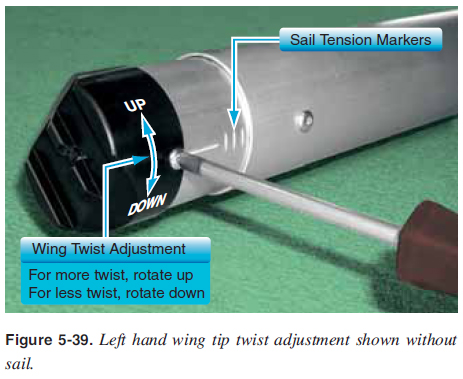
 |
|
||
| CHAPTER 5. Prefl ight and Ground Operations
Wing Tuning Wings are designed to fly straight with a range of trim speeds determined by the manufacturer. If the wing does not fly straight or trim to the manufacturer’s specifications, it must be tuned to fly properly. Any wing adjustment can change the handling and stability characteristics of the wing. Each wing is unique and the tuning procedures are unique for each wing. It is very important to follow the specific tuning procedures in the POH/AFM for the specific wing. The following are general guidelines to understand the tuning process. Tuning the Wing To Fly Straight Wings may turn to the right or left (depending on which way the propeller turns) at high power settings because of the turning effect described earlier in the aerodynamics section. If it does not fly straight for cruising flight, visually examine for any asymmetric right and left features on the wing before making any adjustments. Look for symmetry in the twist angle. Inspect the leading edge for any discontinuities, bumps, or an irregular leading edge stiffener. Ensure the pockets are zippered and symmetrical on both sides. Ensure the reflex lines are clear, straight, and routed properly. Check the battens to ensure the right and left match (do not make any adjustments in the battens initially because reflex may have been added at the factory initially for tuning), and ensure the battens match the manufacturer’s batten pattern. Check the batten tension on both sides and the leading edge tension to ensure it is symmetrical. If it is a used wing just acquired, research the history of the wing to see what might have happened which would cause it to not fly straight. For new wings, contact the manufacturer for advice. If these checks do not make the wing fly straight, then adjust the twist in the wing according to the manufacturer’s instructions. More twist on one side decreases angle of attack, produces less lift, and will drop the wing, which makes it turn in the direction where more twist was added. For example, with an unwanted left hand turn, either decrease the twist on the left hand wing (increase angle of attack at the tip) or increase the twist on the right hand wing (decrease the angle of attack at the tip). Batten tension is one way of fixing very mild turns. Increasing the batten tension at the tips especially decreases twist and raises the wing. For normal mild turns, most wings have an adjustment at the tip where you can rotate the wing tip around the leading edge. This is the easiest and most effective wing twist adjustment. [Figure 5-39] For some models, reflex at the root can be adjusted on a side to adjust a significant turn. More reflex on a side means wing up, similar to reducing twist in a wing. As emphasized above, the POH for each manufacturer must be used for adjusting twist for wing tuning.  Adjusting the tension on the leading edge is another method of adjusting the wing twist. However, different wings will react differently when tension is adjusted, so the POH must be followed for a particular wing. Some manufacturers do not suggest adjusting sail tension to adjust twist, but require equal tension with other adjustments to remedy an unwanted turn. For those wings utilizing asymmetrical sail tension to adjust twist, the following information is provided. Adjusting sail tension is most effective on slower wings with lots of twist. Adjusting sail tension affects some high performance wings differently, making it necessary to consult the POH. However, on most wings, increasing sail tension at the tip increases leading edge flex, resulting in more twist. Tuning the Wing To Fly Slower or Faster Most wings allow the hang point attachment to move forward to increase trim speed and back to decrease trim speed. If there is a situation where the hang point is at the most forward position and the wing trims below the manufacturer recommended speed, or the trim speed is within 10 miles per hour (mph) of the stall speed, an alternate method for increasing the trim speed is needed. For this situation, the twist must be reduced symmetrically to increase the angle of attack on the tips so they provide more lift and lower the nose for proper trim. This can be done by pulling back more on the crosstube tensioning cables which reduces the twist in the wing. However, this procedure reduces the stability of the wing and decreases the handling ability of the wing because it is stiffer. This is a common adjustment for hang gliding wings for inflight trim, however this adjustment should only be made on WSC wings as specified in the POH for a specific wing. Raising and lowering the reflex lines affects airfoil reflex and also changes the trim speed of the wing. Lower reflex lines speed the wing up and make it less stable, raising the reflex lines slows the wing and make it more stable. Some manufactures have this as an adjustable setting which can be varied during flight, other manufactures have this adjustment where it can be made on the ground. Other manufactures do not recommend this adjustment because it can lower the certified stability of the wing. |
| ©AvStop Online Magazine Contact Us Return To Books |